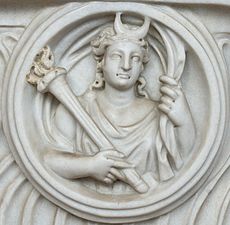Velificatio

Velificatio is a stylistic device used in
A figure so framed is a velificans (plural velificantes). Not all deities are portrayed as velificantes, but the device might be used to mark a member of the

Velificatio is a frequent device in Roman art,
Usage and examples
In
Fertile in produce and cattle, let Tellus grant Ceres a crown of grain; let the healthful waters and breezes of Jove nourish offspring.[12]
Not all scholars agree on this analysis of the scene. The creatures on which the velificantes are seated also suggest Nereids, and the reference may point to the Cult of the Nymphs.[13]
The significance of the veil is sometimes explained in terms of the
-
Europa(mosaic, 1st-2nd century)
-
Pluto (cinerary urn, 2nd century).
-
Neptune (mosaic, 3rd century).
-
French Empire mantel clock (1822) depicting the nereid Galatea.
-
Aura of Las Incantadas (marble relief, 2nd century AD).
Outside Greco-Roman culture
Greek deities were abundantly used in Greco-Buddhist art, so too their depiction elements, as with the Boreas and its velificatio element. Boreas became the Japanese wind god Fujin through the Greco-Buddhist Wardo/Oado and Chinese Feng Bo/Feng Po ("Uncle Wind"; among various other names), spreading the velificatio as an element of portraying deities of the sky.[15][16][17]
List of velificantes
The velificatio motif may be found with numerous deities, divine beings, and divi, including:[18]

- Nyx
- Aura
- Nereids
- Horae (Seasons)
- Maenads
- Niobids
- Niobe
- Selene or Luna[19]
- Helios
- Caelus[20]
- Europa
- Dionysus
- Ariadne
- Poseidon or Neptune
- Amphitrite
- Aphrodite or Venus
- Mars[21]
- Tarpeia[22]
- Vibia Sabina[23]
See also
References
- ^ Paul Rehak, Imperium and Cosmos: Augustus and the Northern Campus Martius (University of Wisconsin Press, 2006), p. 111.
- ^ Robert Turcan, Les religions de l'Asie dans la vallée du Rhône (Brill, 1972), p. 21.
- ^ Stefania Sorrenti, "Les représentations figurées de Jupiter Dolichénien à Rome", in La terra sigillata tardo-italica decorata del Museo nazionale romano, «L'Erma» di Bretschneider, 1999), p. 370.
- ^ Lise Vogel, The Column of Antoninus Pius (Harvard University Press, 1973), p. 45.
- ^ Hélène Walter, La Porte Noire de Besançon (Presses Univ. Franche-Comté, 1984), vol. 1, p. 332.
- ^ Pliny, Natural History 36.29; Davide Stimilli, The Face of Immortality: Physiognomy and Criticism (State University of New York Press, 2005), p. 172.
- ^ Brunilde Sismondo Ridgway, Hellenistic Sculpture II: The Styles of ca. 200–100 B.C. (University of Wisconsin Press, 2000), passim.
- ^ The term is so used in the art criticism of Walter Benjamin; Aleida Assmann and Jan Assmann, "Air From Other Planets Blowing: The Logic of Authenticity and the Prophet of the Aura", in Mapping Benjamin: The Work of Art in the Digital Age (Stanford University Press, 2003), pp. 153–154.
- ^ It occurs in Cicero, Ad familiares 1.9.21, and not again in Latin literature until Fronto, 267,4–5; Michel P.J. van den Hout, A Commentary on the Letters of M. Cornelius Fronto (Brill, 1999), p. 608.
- ^ Pliny, Natural History 36.29.
- ^ Thomas Köves-Zulauf, "Plinius d. Ä. und die römische Religion," Aufstieg und Niedergang der römischen Welt II.16.1 (1978), p. 277.
- ^ Fertilis frugum pecorisque Tellus / spicea donet Cererem corona; / nutriant fetus et aquae salubres / et Iovis aurae.
- ^ Babette Stanley Spaeth, "The Goddess Ceres in the Ara Pacis Augustae and the Carthage Relief", American Journal of Archaeology 98 (1994), pp. 77–78.
- ^ Elisabeth Matelli, "Hieronymous in Athens and Rhodes", in Lyco of Troas and Hieronymous of Rhodes (Transaction Publishers, 2004), pp. 294–295.
- ISBN 978-618-84901-1-6.
- OCLC 937316326.
- ISBN 978-1-78969-695-0.
- ^ Unless otherwise noted, the following examples are given by Babette Stanley Spaeth, The Roman Goddess Ceres (University of Texas Press, 1996), p. 223.
- ^ Particularly on Roman-era sarcophagi that depict the myth of Endymion; Sorrenti, "Les représentations figurées", pp. 370, 376.
- ^ The figure at the top of the figured cuirass on the Augustus of Prima Porta is most often identified as Caelus; he is barechested with arms uplifted to support the velificatio; Jane Clark Reeder, "The Statue of Augustus from Prima Porta, the Underground Complex, and the Omen of the Gallina Alba", American Journal of Philology 118 (1997), p. 109. The Caelus on the Belvedere altar is also a velificans; Rehak, Imperium and Cosmos, p. 111.
- Cherchel; Rehak, Imperium and Cosmos, p. 111.
- ^ On the Basilica Aemilia frieze in Rome; Rehak, Imperium and Cosmos, p. 111.
- ^ Vogel, The Column of Antoninus Pius, p. 45.






